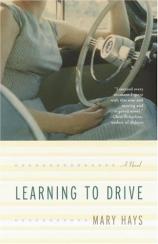Reading Group Guide
Discussion Questions
Learning to Drive

1. Charlotte tells Mel, "I've made up my mind that we should separate" [p. 18]. Is her mind made up before she says the words aloud? Is her decision based on feelings rather than principles? Why is that distinction important?
2. A central tenet of Christian Science is that matter does not exist; humans are subject to the laws of matter only if they believe they are real. Clearly Kitty believes this, while Rosey is less certain. What does Charlotte believe? How does this help or harm her before Mel's death, and how does her thinking change afterward? What is she raising her sons to believe? How does Francis's fascination with deterioration come into play here?
3. Although Charlotte and her sisters were raised in a strictly Christian Science household, both Charlotte and Kitty have married men who aren't Scientists. Why do you think that is? What do you think of Rosey's eventual choice of husband?
4. What is the significance of the Porter? What do you think the quote from J. Smith on the opening page means? How would the novel be different without the Porter passages?
5. Charlotte is one of three sisters, and she herself has two sons. What kind of parallels do you see in the behavior of these single-gender generations? How are their relationships different from Roberta and Norman's? Is Baird more like Kitty or Rosey? Is Hoskins like Charlotte?
6. The idea of perfection comes up again and again: "Charlotte had to be constantly on guard against such thoughts, silently refuting suggestions of Hoskins's imperfection with prayers and reasserting his true identity as a perfect child of God" [p. 25]. Francis declares that deterioration--imperfection--is a reason to believe in God [p. 217]. And Kitty tells Charlotte she will bring on illness by dwelling on imperfection [p. 253]. Who do you agree with? How do these competing convictions shape what happens?
7. Christian Science is a religion of words. Hoskins has many words, yet throughout the book he refuses to use them. What is the significance of this? And what meaning does that give to the words he does speak?
8. Both Charlotte and Kitty make momentous decisions at the end of the novel. Whose do you think was easier to reach? Did either of them make the wrong decision?
9. When Charlotte cuts off her hair, there are several references to death: "Braiding her long hair for the last time, Charlotte felt as though she were dressing the dead" [p. 94]; "The cut ends . . . swung out grotesquely, like helpless climbers having lost their footing" [p. 94]; "She laid the braids out side by side like two corpses" [p. 95]; "And here she was, finally putting her hair to rest" [p. 97]. And yet, once it's cut off, "She looked about twelve" [p. 95]. Nobody recognizes her. Is this rejuvenation/rebirth intentional, or is Charlotte merely acting on impulse? Is Francis's digging up of the lupine field also analogous to death?
10. Christian Science, with its devotion to the written word, is a religion for the educated. Charlotte's father was a professor, Kitty is a teacher, and Charlotte herself is something of a perpetual student. But the residents of Beede, in particular Beatriz, are not of this ilk. As the Porter says to Charlotte, "These are not your people! They know nothing about discipline, reason, hard work. They're common" [p. 162]. If the Porter is a creation of Charlotte's imagination, does this mean these statements are really hers? How do issues of class affect Charlotte's understanding of her faith? Does her time in Beede change her thinking? How does Beatriz's exposure to Christian Science influence her expectations of Ben Hightower?
11. Why do you think this book was set in 1952 --- 53? What does McCarthyism have to do with the central themes of the novel?
12. Distinctions are drawn between the Christian Science belief in the power of thought--"A sick body is evolved from sick thoughts" [p. 64]--and superstitions, like Baird's reliance on a horse chestnut for good luck [p. 23] or Rita's many rituals [p. 213]. But towards the end of the novel, Charlotte realizes, "If you juggled the facts around enough, you could fool yourself into thinking you could control the whole course of your life--or someone else's" [p. 264]. She seems to equate thought and superstition, and finds them equally lacking. Why do you think she has undergone such a radical change in thinking?
13. The author, Mary Hays, is sixty-three and publishing her first novel. How might her age and life experiences have influenced the type of book she wrote?
Learning to Drive
- Publication Date: October 12, 2004
- Paperback: 320 pages
- Publisher: Anchor
- ISBN-10: 1400031907
- ISBN-13: 9781400031900







